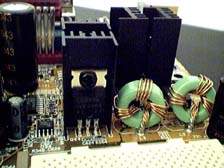FIC AZ11E Socket-A KT133 (686B) ATX
by Henry Kuo on November 15, 2000 12:00 PM EST- Posted in
- Motherboards
The Features
Just like most other KT133 motherboards, you can read the temperature of the CPU and the system in the PC Health panel inside the BIOS. There are two fans connectors available on the board, and their speed are shown inside the PC Health panel as well, together with the CPU core voltage.
Manufacturers have been stressing stability these days much more than in the past, something that is quite evident with the AZ11E. As we mentioned before, FIC took the effort to re-route many of the traces throughout the board. That definitely played a role in boosting the performance of the board, but at the same time it also helped in reducing noise and interference that affect stability greatly. As if that weren't enough, FIC decided to add some huge capacitors. The Microstar K7T Pro2 was among the first using 4700uF capacitors, and FIC simply followed the path and put in a total of four 4700uF, two 3900uF, and one 2200uF capacitors around the CPU socket. There are also a couple switching voltage regulators, where four of them have large heat sinks attached. All these help to provide clean signals to the CPU, a big part of why the board was rock solid in our stability tests.
 |
 |
The VIA 8363 North Bridge sits beside the CPU socket, and is the core of the KT133 chipset. It provides all the major features of the KT133, including the 133MHz memory bus and AGP 4X support. The AGP Slot is a "universal slot," meaning that it is not keyed specifically for AGP 2X or AGP 4X cards, so the user can install almost any current AGP card in the slot.
There are three DIMM slots on the AZ11E, allowing a maximum of 1.5GB SDRAM. The 8363 memory controller allows you to run your memory at either 133MHz or 100MHz. Therefore, users with PC133 SDRAM can take advantage of the increased bandwidth over PC100 SDRAM, going from 800MB/s to 1.06GB/s. This can be done easily in the BIOS by choosing either 100MHz or 133MHz memory clock. There is also a setting for CAS latency in the BIOS, so users can push their memory to the limit if they have some good memory.
With the AZ11E, FIC replaced the "old" VIA 686A Super South Bridge with uses the newer 686B model. It offers everything you can find on the VIA 686A, including, a second USB root hub, AC'97 audio support, integrated hardware monitoring, and a PCI to ISA bridge. The advantage of the 686B over 686A is that the 686B supports for Ultra ATA 100, whereas the 686A only supports Ultra ATA 66. At this point, there is no hard drive with a sustained transfer rate of higher than 40MB/sec, so Ultra ATA 100 is not really necessary. However, it will not take long before that barrier is broken, so it is definitely a plus for the motherboard to be Ultra ATA 100 ready.
The 5/1/0/1 (PCI/CNR/ISA/AGP) expansion slots configuration should be enough for most users, although the CNR slot is an odd choice by FIC, since it is not supported by the 686B South Bridge. Also, the CNR slot is not a shared slot, so we can see that this board is more OEM oriented. However, since there is actually enough space between the fifth PCI slot and the CNR slot, FIC could have made it a perfect six PCI slots configuration. The connectors for USB 3 and 4 are on the left side of the board, but FIC does not provide the necessary expansion bracket to take advantage of those extra USB ports.
The AZ11E uses the Sigmatel STAC9700T AC 97 CODEC to provide basic on-board sound functionality. AC'97 audio provides some basic sound functionality for users on a budget, but for those who are serious about sound should definitely go for a true hardware-based PCI solution.










0 Comments
View All Comments